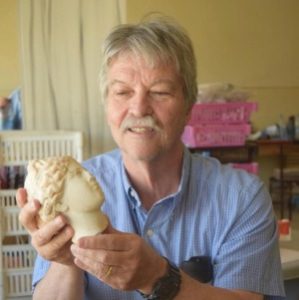
NORTH CAROLINA STATE UNIVERSITY—A team of North Carolina-based researchers helped unearth more clues this summer about the ancient Nabatean city of Petra in Jordan.
As part of a larger excavation at the site, the group of North Carolina State University and East Carolina University faculty and students discovered two marble statues of the mythological goddess Aphrodite — artifacts that dig co-director Tom Parker describes as “absolutely exquisite.”
Parker, a professor of history at NC State, said the team found the pieces while excavating domestic structures in Petra’s North Ridge area during May and June.
“I’ve been doing field work in the Middle East for 45 years and never had a find of this significance,” Parker said. “These are worthy of display at the Louvre Museum or the Metropolitan Museum of Art.”
The statues, which also feature the mythological god Cupid, are largely intact from pedestal to shoulders. Both statue heads and much of their upper extremities were also recovered at the site and will be restored.
This year’s dig marked the third season of the Petra North Ridge Project, an initiative aimed at uncovering clues about the ancient city’s non-elite population. So while the statues are remarkable finds, they’re also somewhat unexpected.
_______________________________
A marble statue of Aphrodite, the Graeco-Roman goddess of love, recovered at Petra in Jordan. A small Cupid on the lower right gazes up at Aphrodite. A handheld glass vial in visible on her left leg, probably from another figure now lost. The statue, about half life-size, probably dates to the second century A.D. Credit: Tom Parker
__________________________________________
NC State Professor of History Tom Parker examines a statue of Aphrodite, discovered during a 2016 excavation in Petra, Jordan. Credit: Courtesy of Tom Parker
____________________________________________________
The team was digging what they thought was an ordinary home this summer when they came across something much more. The house was more like an urban villa, Parker said, equipped with its own sophisticated bath house. The team found the fragmented statues next to the home’s staircase.
“Even though they weren’t exactly what we were looking for, these finds still tell us a lot about the population,” Parker said.
The marble statues are Roman in style, which provide additional insight to the cultural impact of Rome’s annexation of Nabataea in 106 A.D. “The Nabateans were true geniuses in many ways, in part because they were ready and willing to assimilate to and adopt elements of other cultures around them,” Parker said. “They adopted a lot of Egyptian culture when they were neighbors. When Romans took over, they were open to Roman influence.”
The dig team, which Parker co-directs with bioarchaeologist Megan Perry, professor of anthropology at ECU, found a wealth of other artifacts that shed more light on Nabatean daily life. Digging one other domestic structure and three rock-cut shaft tombs, the researchers discovered installations for cooking and storage, occupational remains such as pottery and animal bones, an iron sword, ceramic oil lamps and human bones intermixed with personal adornments and jewelry.
“The human remains and mortuary artifacts from Petra provide perspectives not only on Nabataean concepts of death, but also their biological histories while alive,” Perry said.
Source: North Carolina State University news release.
__________________________________________________
The Petra North Ridge Project is primarily funded by a grant from the National Endowment for the Humanities with additional support from the National Geographic Committee for Research and Exploration. This season’s dig team of 65 workers, including 20 Jordanian personnel, featured an NC State contingent of 14 students, alumni and faculty. Six undergraduate students participated through NC State’s Jordan Archaeological Field School study abroad program. In addition, seven graduate students and NC State alums also participated in the dig, supervising work in the trenches and at the domestic structures.
____________________________________________________________

______________________________________________
Travel and learn with Far Horizons.
____________________________________________
This richly illustrated issue includes the following stories: Recent findings shedding new light on the whereabouts of the remains of Philip of Macedon, father of Alexander the Great; how an archaeologist-sculptor is bringing bones of the dead back to life; archaeologists uncovering town life at the dawn of civilization; an exclusive interview with internationally acclaimed archaeologist James M. Adovasio about what makes the Meadowcroft Rockshelter prominent in the ongoing search for the first Americans; what archaeologists are finding at the site of the ancient city of Gath, the home town of the biblical Philistine giant, Goliath; and how scientists are redrawing the picture of human evolution in Europe. Find it on Amazon.com.







